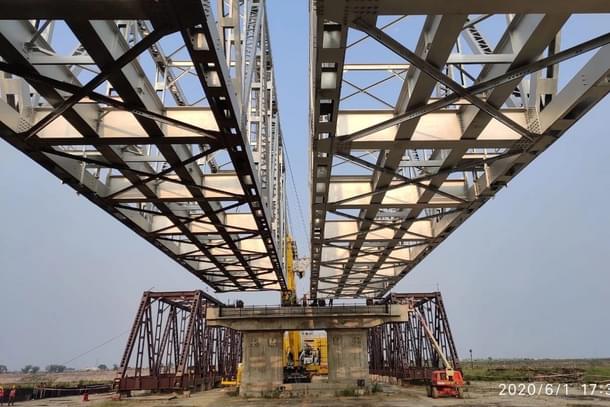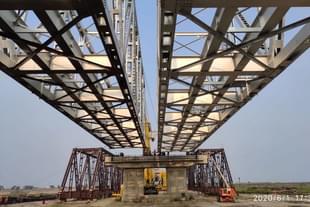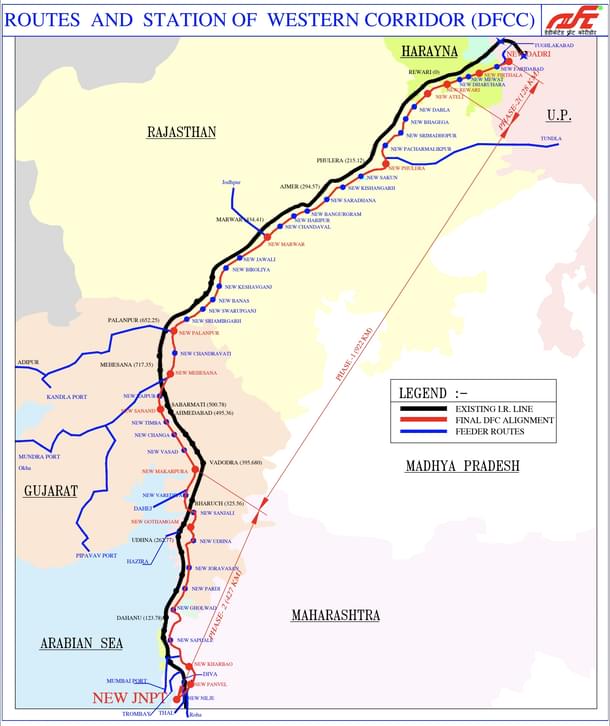Infrastructure
How Western Dedicated Freight Corridor Will Boost Logistics Competitiveness, Save Time And Cost
Amit Mishra
May 13, 2022, 03:57 PM | Updated 03:57 PM IST
Save & read from anywhere!
Bookmark stories for easy access on any device or the Swarajya app.


The plan to construct Dedicated Freight Corridors (DFC) across the country marks a strategic inflexion point in the history of Indian Railways that has essentially run mixed traffic across its network.
The total 3,381 route km project — touted as the largest rail infrastructure being built in independent India — has been in the making since 2006 with little movement on the ground. It is finally ready to take off, albeit in phases.
Once completed, these corridors will enable Indian Railways to improve its customer orientation and meet market needs more effectively. Creation of rail infrastructure on such a scale is also expected to drive the establishment of industrial corridors and logistic parks along its alignment.
So What Exactly Is A DFC?
These DFCs, if described in general colloquial language, are special tracks and arrangements for goods trains.
Infrastructure is the biggest source of competence of any nation. Today, when India is moving fast towards becoming the world’s big economic power, excellent connectivity is the priority of the country. Highways, railways, airways, waterways and i-ways (information ways) — the five wheels required for economic speed are necessary for rapid growth. The DFC is also a major step in this direction.
In the first phase, the government of India has approved construction of two corridors — the 1,875 km long Eastern Dedicated Freight Corridor (EDFC) and 1,506 km long Western Dedicated Freight Corridor (WDFC).
The DFC once constructed will decongest the railways’ network by moving 70 per cent of goods trains to these two corridors.
Western Dedicated Freight Corridor (WDFC)
The WDFC connecting Dadri in Uttar Pradesh to Jawaharlal Nehru Port (JNPT) in Mumbai passes through five states of UP, Haryana, Rajasthan, Gujarat and Maharashtra.
The western corridor covers a distance of 1,504 km through double line electric (2 X 25 KV) track from JNPT to Dadri via Vadodara-Ahmedabad-Palanpur-Phulera-Rewari. The Western DFC is proposed to join the Eastern DFC at Dadri.
Western DFC would mainly cover Rajasthan (565 km), Maharashtra (177 km), Gujarat (565 km) Haryana (177 km) and about 18 km in Uttar Pradesh.
Alignment has been generally kept parallel to existing lines except provision of detour at Diva, Surat, Ankleshwar, Bharuch, Vadodara, Anand, Ahmedabad, Palanpur, Phulera and Rewari. However, it is entirely on a new alignment from Rewari to Dadri.
Traffic Projections
The western corridor will cater mainly to ISO or intermodal containers from JNPT and Mumbai port in Maharashtra and ports of Pipavav, Mundra and Kandla in Gujarat destined for inland container depots (ICDs) located in northern India, especially at Tughlakabad and Dadri. Besides containers, other commodities moving on the western DFC are POL, fertilisers, food grains, salt, coal, iron and steel and cement.
Funding
The entire western corridor is being funded through a loan from Japan International Cooperation Agency (JICA) in two phases.
The Dadri-JNPT corridor is being constructed with JICA funding of Rs 38,722 crore (550 billion Yen). This also includes the cost of 200 electric locomotives to be procured by Indian Railways.

Section-Wise Progress
According to a DFCCIL release, the WDFC has been divided into three sections: Rewari-Palanpur; Palanpur-Makarpura; Makarpura-JNPT and the inter-connecting link to EDFC from Dadri to Rewari.
In the WDFC, a total of 659 km line has been commissioned with about 65 trains running in the section. This includes the 306 km long Rewari-Madar section and Madar-Palanpur section with a length of 353 km.
The subsequent sections are up to Makarpura in Gujarat (to be done by March 2022), and finally to JNPT (June 2022).
Rewari-Madar Section
WDFC’s 306 km Rewari-Madar section was dedicated to the nation on 7 January 2021. The Rewari-Madar section is situated in Haryana (approximately 79 Km, in Mahendragarh and Rewari districts) and Rajasthan (approximately 227 Km in Jaipur, Ajmer, Sikar, Nagaur and Alwar districts).
The opening of this stretch will benefit various industries in Rewari — Manesar, Narnaul, Phulera and Kishangarh areas of Rajasthan and Haryana and National Capital Region. In addition to this, the container depot of CONCOR at Kathuwas will also come on the DFC map and get advantage in terms of faster throughput.
This section will also ensure seamless connectivity of the western ports of Kandla, Pipavav, Mundhra, and Dahej situated in Gujarat with the northern parts of India.
With the dedication to the nation of the 351-km Bhaupur-Khurja section, and construction of a connecting link between Khurja-Boraki-Dadri-Rewari, seamless movement between WDFC and EDFC can ensue.
Madar-Palanpur Section
Trial run of freight train in Madar-New Palanpur section (353 km) of WDFC was conducted on 31 March 2021 and was declared open for operation in October 2021.
This section falls between Rajasthan (approximately 333 km in Sirohi, Pali and Ajmer districts) and Gujarat (19 km in Banaskantha district).
Passing through the Aravalli range of mountains, the section is expected to provide easy access to the cement cluster for western Uttar Pradesh, Gujarat and Madhya Pradesh.
According to a senior railway official, the section contains suitable deposits of cement raw material with 10 million tonnes loading capacity of three cement sidings which will result in faster connectivity of the DFC.
Double Stack Long Haul Container Train Operation
In a first, double stack 1.5 km long electric train had run in DFCCIL’s newly commissioned 7.5 metre high OHE Section between New Ateli and New Kishangarh stations. In one train, 360 ten feet container equivalent units (TEU) are moving which is equivalent to 270 high capacity road trailer trucks.
Double stack long haul container train operation has an enhanced axle load of 25 tonnes. It has been designed for DFCCIL by RDSO’s wagon department. These wagons on a long-haul double stack container train on the WDFC can carry four times in terms of container units compared to the current traffic on Indian Railways.
The Game Changer
The project is an important part of "Delhi-Mumbai Industrial Corridor (DMIC) initiative", which is Japanese-Indian collaboration for comprehensive infrastructure development to create India's largest industrial belt by linking the industrial parks and harbours of the six states between Delhi and Mumbai in order to promote foreign export and direct investment, particularly those in Japan.
Under the DMIC initiative, plans are also being implemented to create industrial parks and logistics bases with well-developed infrastructures in an area of 150 kms on either side of the western corridor.
According to a newspaper report, the commissioning of the WDFC up to the Gujarat ports of Mundra and Pipavav in financial year 2022 (FY22) should lead to time-guaranteed delivery of consignments by the railways, leading to 9 percentage point market share shift from road to rail over FY 22-26. The fact that WDFC freight rates will be lower than existing rail rates by 16-20 per cent by FY26 will boost Indian logistics’ competitiveness, both from a cost and timeliness perspective.
Amit Mishra is Staff Writer at Swarajya.





